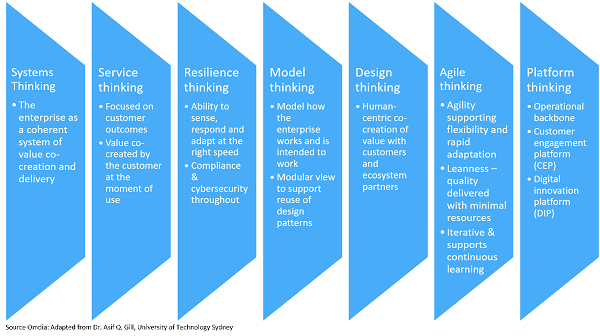In today’s extreme Darwinian environment, the ability to sense change and respond effectively demands a different way to view the organization. You have to think of your business not as a collection of linear processes organized into siloed departments with the customer at the end of the line, but rather as a living system of value creation and delivery. Living systems are connected and can sense, respond, and adapt to stay relevant.
In a living system’s environment, the company acts like an intelligent organism, adaptive by nature. In this enterprise-as-an-organism, people provide the grey matter and creativity, and technology connects them to customers and helps employees collaborate, share knowledge and insight, and add value to our customers. This represents a significant cultural shift for most companies and a reframing of the organization by visionary CEOs, providing a compelling sense of purpose and the means to emancipate employees from the shackles of monotonous tasks and instead tap into their aspirations for higher meaning.
Stuck in a 20th-Century Industrial Age Mindset
If you look at any failed business, the seeds of that failure are more often than not down to an inability to detect and act on the signals of change coming from outside the enterprise. In time, myopic businesses find their customers deserting them for more relevant brands. Why is it so difficult for firms to transform themselves and keep up with customers' ever-rising expectations?
Despite all the advances in technology, the Industrial Age command-and-control patterns of behavior are still too common, especially in public companies answerable to shareholders before customers or employees. Decision making in these companies is too slow, and the C-suite is far removed and often shielded from the realities at the edges, between the business and its customers. The annual budget cycle typically parcels out resources based on the size of the department or business unit, not to where they need to be to fuel the next growth opportunities. Such organizations are sclerotic with blocked information arteries, and fail to adapt at the right pace to ensure persistent relevance.
Accelerating Transformation
As I discussed in my last
No Jitter post, enterprises require a new set of value disciplines to close the growing customer expectation gap. Briefly, the three value disciplines, all driven by customer insight, are:
- Operational excellence — streamline and automate the value chain/network
- A holistic approach to customer experience
- Continuous innovation
Operational excellence provides a foundation for the business, but the other two are the real growth engines and ensure persistent relevance. Enteprises must integrate these value disciplines, and not treat as them as silos. To aid strategic thinking and to create a more customer-adaptive living organization/organism,
Asif Gill, a computer science professor at University of Technology, Sydney, highlights six types of required thinking. As you can see in the graphic below, I’ve added a seventh — platform thinking.
The six forms of thinking Gill outlines will help develop the clarity and insight to bring the enterprise to life. Platform thinking also aids the destruction of departmental silos that create barriers for customers and employees. Platforms are cross-organizational, and three require development:
- An operational backbone (as described in Designed for Digital, from The MIT Press), in support of operational excellence
- A customer engagement platform — to create a unified environment in support of class-leading customer experience
- A digital innovation platform — to create a growing repository of applications, microservices, and re-usable code for others to embed in new products or to assemble new services
The barrier to this highly adaptable and living system isn’t technology but a lack of strategic and holistic thinking. It’s time for a drastic change to a living systems mindset.











